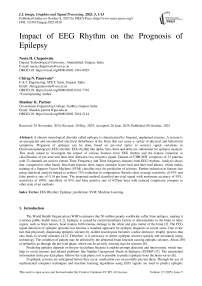Impact of EEG Rhythm on the Prognosis of Epilepsy
Автор: Neeta H. Chapatwala, Chirag N. Paunwala, Shankar K. Parmar
Журнал: International Journal of Image, Graphics and Signal Processing @ijigsp
Статья в выпуске: 5 vol.17, 2025 года.
Бесплатный доступ
A chronic neurological disorder called epilepsy is characterized by frequent, unplanned seizures. A seizure is an unexpected and uncontrolled electrical disturbance in the brain that can cause a variety of physical and behavioral symptoms. Prognosis of epilepsy can be done based on pre-ictal (prior to seizure) signal variations in Electroencephalogram (EEG) rhythm. EEG rhythm like alpha, beta, theta and delta are substantial for epilepsy analysis. This study aimed to investigate the impact of various features from EEG rhythm and the feature reduction in classification of pre-ictal and inter-ictal (between two seizures) signal. Dataset of CHB-MIT comprises of 23 patients with 23 channels are used to extract Time, Frequency and Time-frequency features from EEG rhythms. Analysis shows that, compared to other bands, beta band features show major variation in pre-ictal and inter-ictal phases, which makes training of a Support Vector Machine (SVM) classifier easy for prediction of seizures. Further reduction in feature size using statistical analysis helped to achieve 75% reduction in computation. Results show average sensitivity of 93% and false positive rate of 0.14 per hour. The proposed method classified pre-ictal signal with maximum accuracy of 95%, sensitivity of 100%, specificity of 93% and false positive rate of 0.07per hour with reduced complexity compare to other state of art methods.
EEG Rhythm, Epilepsy, prediction, SVM, Machine Learning
Короткий адрес: https://sciup.org/15019976
IDR: 15019976 | DOI: 10.5815/ijigsp.2025.05.01


